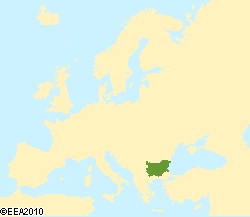Document Actions
Country profile - Distinguishing factors

Located in south-eastern Europe, Bulgaria shares borders with Romania, Greece, Turkey, Serbia and the Republic of Macedonia. To the east the Black Sea defines the extent of the country. Bulgaria’s land area is 110 993 square kilometres and the total border length is 2 245 km. Bulgaria is divided into 28 oblasts or regions and 262 obshtinas or municipalities (Source: NSI - http://www.nsi.bg).
Bulgaria is located within the temperate climate belt and has two climate zones, divided by the Stara Planina mountain range. Winters are generally colder in northern Bulgaria and milder in southern Bulgaria. Winter temperatures vary from zero to -7˚C and on rare occasions, temperatures may drop to -20˚C. In spring, the weather is unsettled, which is typical of a continental climate. The climate is particularly suitable for fruit trees and their produce has been famous across Europe for centuries. Summers are hot and stifling in the north, especially along the Danube. Southern Bulgaria is influenced by Mediterranean weather and does not feature the same temperature extremes, generally staying within the temperate limits of 28-30˚C. Autumn is typically wetter than spring and most rain falls in May, October and November.
Since 1990, social and economic changes in Bulgaria have had a significant demographic impact and have led to a long-term decrease in the population. By late 2007, it had fallen to 7 640 238, representing a drop of 39 000 or 0.5 per cent against 2006. By 2015, Bulgaria's population is expected to decline further as a result of negative natural growth and emigration, to around 7 130 000.
The population is unevenly distributed across the country. In 2007, there were 5 403 200 people living in urban areas (70.7 % of the population) while those in rural areas numbered 2 237 000 (29.3 %). Average population density is 68.9 inhabitants per square kilometre. Population concentrations tend to be the first sign of pressure on the environment when measured in terms of air pollution, demand for drinking water, soil degradation and loss of biodiversity. In Bulgaria, the trend towards urbanisation is strong and annual rates are rising (Source: NSI - http://www.nsi.bg).
The Ministry of the Environment and Waters (MoEW) implements national policy to protect Bulgaria’s environment and ensure compliance with European and international environmental standards. At regional level, environmental policy is implemented by 16 regional environment inspectorates. Water management, organised at drainage basin level, is implemented by four drainage basin administrations (Source: MoEW - http://www.moew.government.bg).
The Executive Environment Agency, ExEA, is a specialised MoEW body which monitors and conducts analytical and laboratory research, gathers and processes information on the state of the environment and produces assessments and reports on the environment at the national and international level (Source: ExEA - http://eea.government.bg/eng).
Under the Environmental Protection Act local government is responsible for environmental protection within the 262 municipalities.




